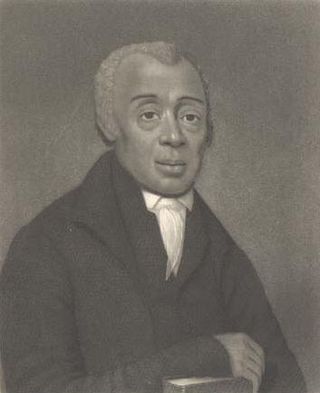
Richard Allen was a minister, educator, writer, and one of the United States' most active and influential black leaders. In 1794, he founded the African Methodist Episcopal Church (AME), the first independent Black denomination in the United States. He opened his first AME church in 1794 in Philadelphia.

William Meade was an American Episcopal bishop, the third Bishop of Virginia.

Christ Church Cathedral, located today at 2919 St. Charles Avenue, in New Orleans, Louisiana, in the United States, was the first non-Roman Catholic church founded in the entire Louisiana Purchase territory. It was founded in 1803 as Christ's Church by the Protestant inhabitants of New Orleans, and is today the official seat of the Bishop of Louisiana, in the Episcopal Diocese of Louisiana.

The Diocese of Ohio is part of the worldwide Anglican Communion represented in the United States by The Episcopal Church. It was organized in 1817 and was the first diocese established outside of the original 13 colonies. The first bishop was Philander Chase. Since that time the Diocese has been served by 11 additional bishops. The 12th and current bishop, the Right Reverend Anne B. Jolly was ordained and consecrated as bishop in April 2023.

The Reformed Episcopal Church (REC) is an Anglican Church. It was founded in 1873 in New York City by George David Cummins, a former bishop of the Protestant Episcopal Church.

James Martin Gray was a pastor in the Reformed Episcopal Church, a Bible scholar, editor, hymn writer, and the president of Moody Bible Institute, 1904-34.

St. Paul's Cathedral is the mother church of the Episcopal Diocese of Fond du Lac and is located in Fond du Lac, Wisconsin which is the see city of the diocese.

Horatio Potter, was an educator and the sixth bishop of the Episcopal Diocese of New York.

The Episcopal Diocese of West Virginia is a diocese of the Episcopal Church in the United States of America (TEC). It encompasses all 55 counties of West Virginia. The diocese has 66 congregations, including 38 parishes, 26 missions, and 2 other churches. The diocese is headquartered in Charleston and led by The Rt. Rev. Matthew Davis Cowden who was consecrated as bishop coadjutor in March, 2022 and became bishop diocesan in October, 2022.

The Episcopal Diocese of Kentucky is a diocese of the Episcopal Church in the United States of America, encompassing the western half of the state of Kentucky.

John Johns was the fourth Episcopal bishop of Virginia. He led his diocese into secession during the American Civil War and later tried to heal it through the Reconstruction Era. Johns also served as President of the College of William and Mary in Williamsburg before that war, and led and taught at the Virginia Theological Seminary in Alexandria after the war.

George David Cummins was an American Anglican Bishop and founder of the Reformed Episcopal Church.

The Episcopal Church (TEC), based in the United States with additional dioceses elsewhere, is a member church of the worldwide Anglican Communion. It is a mainline Protestant denomination and is divided into nine provinces. The presiding bishop of the Episcopal Church is Michael Bruce Curry, the first African American bishop to serve in that position.

Bishop Cummins Reformed Episcopal Church is a Reformed Episcopal Church congregation in Catonsville, Maryland. Founded in 1874, the building it occupied in Baltimore from 1879 to 1961 is listed on the National Register of Historic Places under the name Cummins Memorial Church.

Trinity Episcopal Cathedral, formerly known as Grace Cathedral, is the historic cathedral in the Diocese of Iowa. The cathedral is located on the bluff overlooking Downtown Davenport, Iowa, United States. Completed in 1873, Trinity is one of the oldest cathedrals in the Episcopal Church in the United States. It was individually listed on the National Register of Historic Places in 1974. In 1983 the cathedral was included as a contributing property in the College Square Historic District, which is also listed on the National Register.

The Diocese of the Southeast is a Reformed Episcopal Church diocese and as such an Anglican Church in North America founding diocese. The diocese comprises 32 parishes, 30 in South Carolina and 2 in Georgia, in the United States. Its headquarters are located in Summerville, South Carolina. The current bishop ordinary is Willie J. Hill Jr., who was installed in September 2022.

Evangelical Anglicanism or evangelical Episcopalianism is a tradition or church party within Anglicanism that shares affinity with broader evangelicalism. Evangelical Anglicans share with other evangelicals the attributes of "conversionism, activism, biblicism and crucicentrism" identified by historian David Bebbington as central to evangelical identity. The emergence of evangelical churchmanship can be traced back to the First Great Awakening in America and the Evangelical Revival in Britain in the 18th century. In the 20th century, prominent figures have included John Stott and J. I. Packer.
Ethan Allen was an Episcopal priest and author, the first historian of the Episcopal Diocese of Maryland.

St. James's Episcopal Church is the third oldest Episcopal congregation in Richmond, Virginia. Only the older St. John's Episcopal Church on Church Hill also remains an active congregation.
Willie James Hill Jr. is an American Anglican bishop currently serving as bishop ordinary of the Reformed Episcopal Church's Diocese of the Southeast and as rector of St. John's Reformed Episcopal Church in Charleston, South Carolina.



















